RDP 8704: The Role and Consequences of Investment in Recent Australian Economic Growth 2. Investment And Capital: Some Post-War Trends
April 1987
2.1 Trends in investment
Over a long period, gross investment by the Australian economy (unless otherwise stated, gross investment will include business fixed investment, investment in dwellings and public sector investment) has shown considerable volatility. Figure 2.1 shows data for gross investment as a proportion of GDP, since the turn of the century. Changes in the quality of data over time mean that comparisons over long periods should be made with a degree of caution. This caveat given, two features of Figure 2.1 are particularly striking:
- first, the average investment ratio roughly doubled to around 26 per cent of GDP in the post-war period; and
- second, cycles in the investment ratio have been considerably smaller in the post-war period than previously.
GROSS FIXED CAPITAL FORMATION
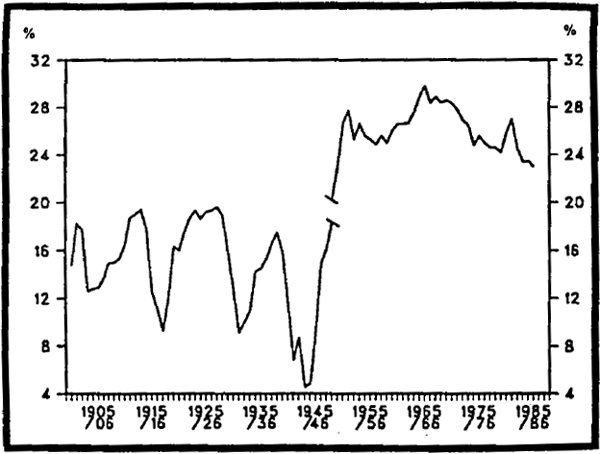
The influence of the two world wars is evident in Figure 2.1. From a twentieth century high of around 19–1/2 per cent in 1914, the investment ratio fell to a low of less than 9–1/2 per cent by 1918. Then, after recovering slowly from the depression low of around 9 per cent in 1932 to around 17–1/2 per cent in 1939, the investment ratio again fell sharply to less than 5 per cent in 1944 and 1945. In contrast, the Korean War (1950–1953) appears to have had little effect on investment. The size of the swings in investment in the two world wars is, however, amplified by the treatment in the National Accounts of military expenditure as entirely current consumption. To the extent that investment in military hardware (though in one sense this is more destructive than constructive capital) replaced private investment in these periods, the amplitude of the fluctuations will be overstated.
Not only has the post-war gross investment ratio been high by Australian standards, it appears to have been high by international standards. Figure 2.2 shows gross investment ratios for Australia and the average for all OECD countries since 1960. While the investment ratio for Australia is still above the OECD average, the gap between the two has narrowed considerably since the start of the 1970s. An exception to this convergence of trends is the three-year period from the beginning of the 1980s when Australian investment was boosted sharply by improved prospects in resource-based industries following the second major oil price rise late in 1979.
GROSS FIXED CAPITAL FORMATION
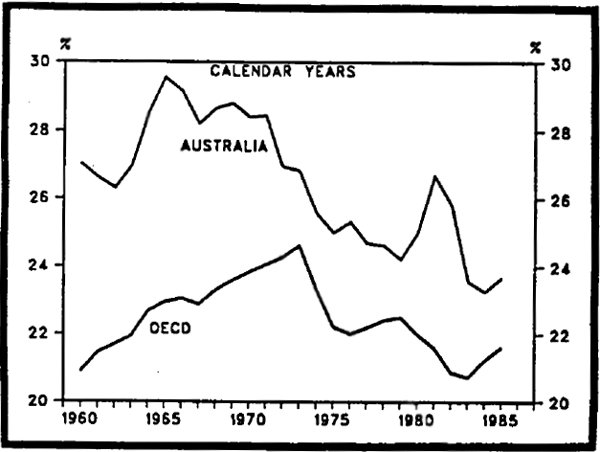
Abstracting from the resources boom, the past decade has seen a similar downward trend in investment in both the OECD and Australia. However, the extent to which Australian investment growth has slowed relative to that in the OECD area over the longer period shown in Figure 2.2 is reflected in the fact that real investment in the OECD has increased by almost 130 per cent since 1960, compared with an increase of just over 100 per cent for Australia.
Gruen (1986) presents evidence of a relatively low rate of increase in investment per person employed in Australia. Although real investment per person in Australia is still above the OECD average, it has grown by only 25 per cent since the early 1960s, compared with growth of the OECD average of just under 40 per cent. Australia's relatively high rate of population growth, of course, accounts for the divergence between gross investment ratios for Australia and the OECD group.
Figure 2.3 shows separately the levels of gross investment (as a ratio to GDP) by the public and private sectors in Australia since 1950.[1] Private investment shows very sharply the effects of the resources booms in the late 1960s and early 1980s but, otherwise, has shown little net decline as a proportion of GDP since the beginning of the 1960s. Investment by the public sector declined during the Korean War then rose steadily to a peak in the mid 1960s. Thereafter, it has shown a fairly steady downward trend, despite a temporary surge in the mid 1970s associated with a general increase in government spending at that time.
GROSS FIXED CAPITAL EXPENDITURE
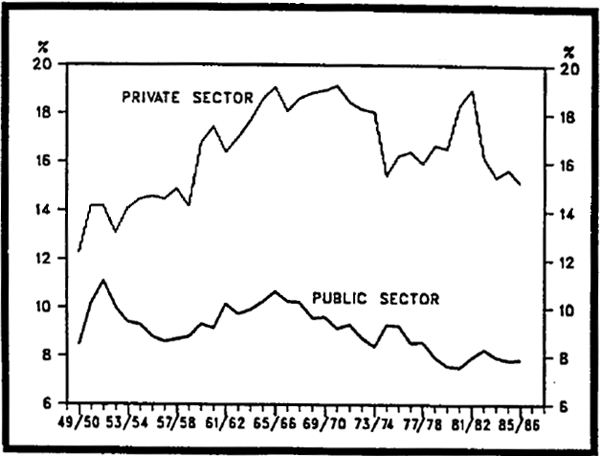
Further decomposition of private sector investment by type is given in Figure 2.4. Investment in dwellings, while subject to cyclical swings, has grown steadily since 1960 and, as a proportion of GDP, has stayed relatively constant at a little over 5 per cent. Investment in non-dwelling construction grew steadily up to the early 1970s, before falling sharply over the following half decade. A strong rise with the resources boom in the early 1980s brought the level of real investment in non-dwelling construction back to its level of the early 1970s though, as a ratio to GDP, it fell from just over 3 per cent of GDP in the 1960's to about 2–1/2 per cent in the early 1980s. However, since the recession in 1982/83, investment in non-dwelling construction has been the dominant source of investment spending.
PRIVATE GROSS FIXED CAPITAL EXPENDITURE
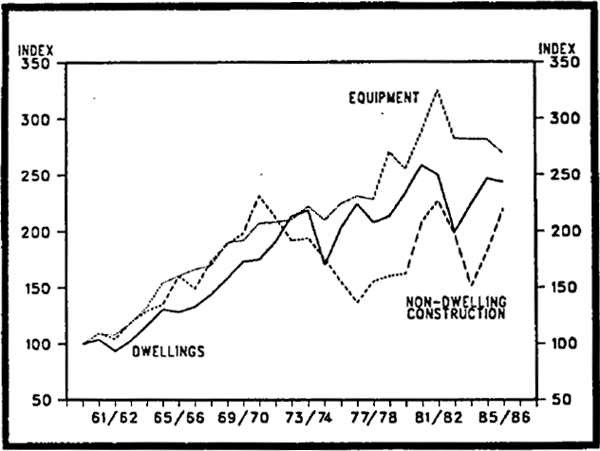
Investment in plant and equipment is the largest component of private sector investment, averaging a little over 8 per cent of GDP over the period shown in Figure 2.4. Like non-dwelling construction it also shows the impact of the resources boom. Unlike non-dwelling construction, however, investment in plant and equipment continued to grow, albeit modestly, throughout most of the 1970s.
The divergent trends between investment in plant and equipment on the one hand and construction on the other reflect, in large part, trends in the industrial structure of the Australian economy. In the first half of the 1960s, investment in mining accounted for less than 2–1/2 per cent of total private investment; over the first half of the present decade, it accounted for more than 10 per cent of the total. In contrast, the manufacturing sector's share fell from over 20 per cent of private investment to around 16 per cent over the same period. Investment in plant and equipment is concentrated in manufacturing industry, while investment in mining and property development is largely in the form of construction.
Gross new private investment by industry is shown as a proportion of output in those industries in Figure 2.5. The picture for mining in Figure 2.5 is dramatic. Throughout the 1960s, investment in mining surged as the nation sought to tap its mineral wealth in the face of buoyant commodity prices around the world. In 1969 and again in 1971, investment in the mining industries accounted for almost 75 per cent of the value of production of these industries. The decline in this ratio after 1972 reflects both reduced investment spending and increased mining output flowing from the earlier investment.
PRIVATE FIXED CAPITAL EXPENDITURE BY INDUSTRY
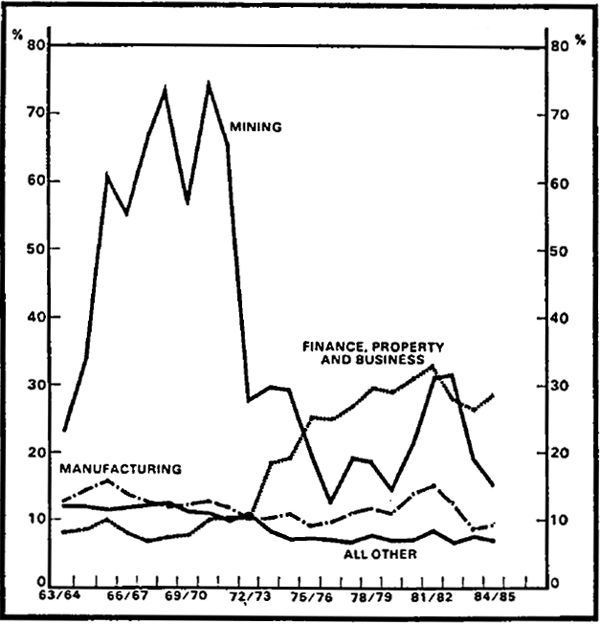
Investment in manufacturing industries has remained relatively steady as a proportion of manufacturing output. However, with growth of the latter being relatively subdued over the period, so too has been the growth of investment spending in manufacturing. Investment in finance, property and business services has shown a strong rise since the start of the 1970s. This trend was helped by a property boom throughout much of the 1970s and, more generally, by the expansion of tertiary industry, especially finance. As discussed below, the strength of the rise has been overstated as a result of a general increase in leasing since the start of the 1970s.
Of the remaining industries (grouped together under “all other” in Figure 2.5), the ratio of investment to output in agriculture has been on a secular decline, while in wholesale and retail trade it has shown little change.[2]
The rapid growth of investment in finance, property and business services raises a difficult issue. The Australian Bureau of Statistics (ABS) allocates expenditure on capital to the industry registering ownership of the capital, rather than the industry in which it is used. This means that all leased buildings, plant and equipment are recorded as investment by the lessor, most often a financial institution or property developer. The rapid growth of investment in finance, property and business services may, at least in part, reflect the rapid growth of leasing from about 4 per cent of business fixed investment in 1967/68 to over 16–1/2 per cent by 1985/86.
Data are available for leasing of plant and equipment by industry since 1985. While it is not possible to accurately adjust data prior to 1985 for leasing, some idea of the impact of leasing can be obtained by rough approximation. In adjusting the data prior to 1985 we have assumed that leasing undertaken by each industry bears a constant relationship to its share of GDP in each year; the shares are based on trends since 1985. The unadjusted series are shown as an index in Figure 2.6a. Figure 2.6b shows the same data adjusted approximately for leasing. For ease of comparison, both graphs are drawn to the same scale.
For most industries the adjustment for leasing does not change the long-run picture dramatically. But, not surprisingly, there is a major change in investment by finance, property and business. Although the property boom and the expansion of the finance industry are still reflected in the data, more than half the investment undertaken by this sector since the early 1970s appears to be attributable to investment goods leased to other industries.
PRIVATE FIXED CAPITAL EXPENDITURE BY INDUSTRY
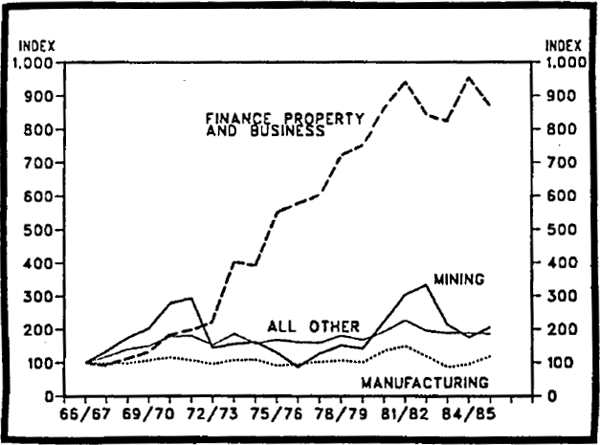
PRIVATE FIXED CAPITAL EXPENDITURE BY INDUSTRY – ADJUSTED FOR LEASING
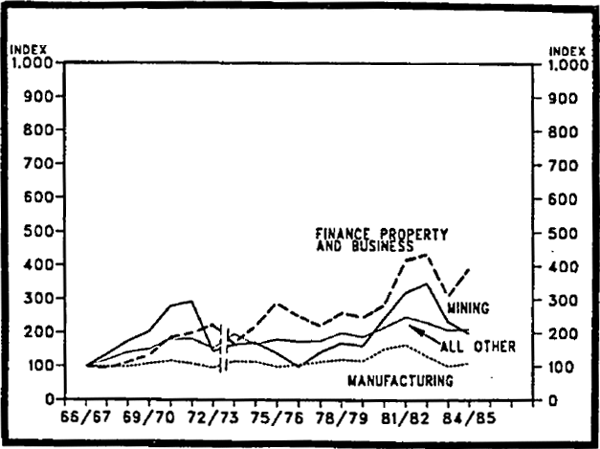
Mining is little affected by the leasing adjustment, since the majority of leasing appears to have taken place in manufacturing and other industries. After adjusting for leasing, the manufacturing sector shows stronger growth in investment throughout the late 1970s but a weaker porformance, relative to the 1970s following the most recent resources boom. Investment by all other industries shows similar trends adjusted and unadjusted, although at a slightly higher level. Our adjustments are, of course, approximate and only one of several possible approaches to the problem. The extent to which the data shown in Figure 2.6b differ from other estimates of the impact of leasing, such as those produced by Hall (1984)[3] , highlights the need to interpret estimates of leasing by industry with caution.
2.2 The aggregate capital stock
Investment spending is of interest in its own right, in particular for its impact on economic activity through its contribution to aggregate demand. More important, however, is the contribution of investment to the stock of productive capital in the economy. While new investment is the primary source of addition to the capital stock, the effective stock is also influenced by the rate of depreciation of existing capital, the rate of technological progress and the compatibility of the existing stock with the desired industrial structure of the economy.
The factors influencing the effective capital stock are not all easily measured and, as a consequence, there is no single, widely-accepted measure of capital. Figure 2.7 shows one measure of capital (public plus private but excluding dwellings) as a ratio to the employed labour force (the capital/labour ratio), where labour is defined in efficiency units; i.e., allowing for technological progress.[4] The measurement of technological progress is explored further in Section 3.
From Figure 2.7, it appears that capital per effective worker followed a steady upward trend until the late 1970s. Since that point there has been a trend decline, punctuated by a temporary rise with the resources boom in the early 1980s. The decline in the past two years has been quite dramatic. The recent fall in the capital/labour ratio reflects both falling investment and a sharp increase in employment. Of course, while the overall pattern of change would be unaltered, assuming a higher rate of technical progress (Figure 2.7 assumes a rate of technological progress of 1.1 per cent per annum) would tend to show the capital/labour ratio as flatter in the period prior to the mid 1970s and declining more sharply thereafter.
CAPITAL/LABOUR RATIO
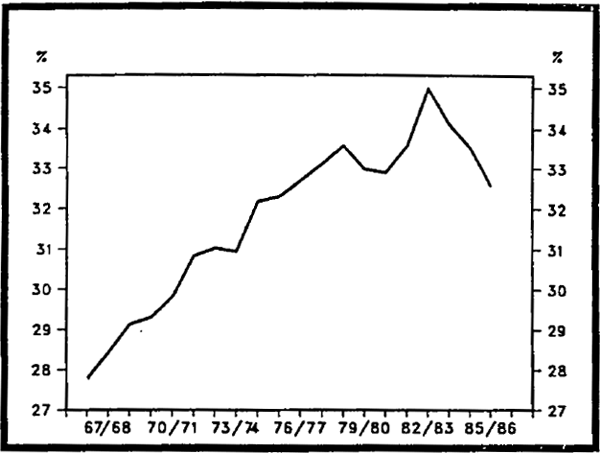
Figure 2.8 shows the output/labour and output/capital ratios based on the data used in Figure 2.7. Consistent with the pattern in the capital/labour ratio, output per efficiency unit of labour tended to rise throughout the period to the mid 1980s (although at a much faster rate through the first half of this period) before declining, while output per unit of capital declined until the end of 1982, after which point it rose sharply.
OUTPUT RATIO
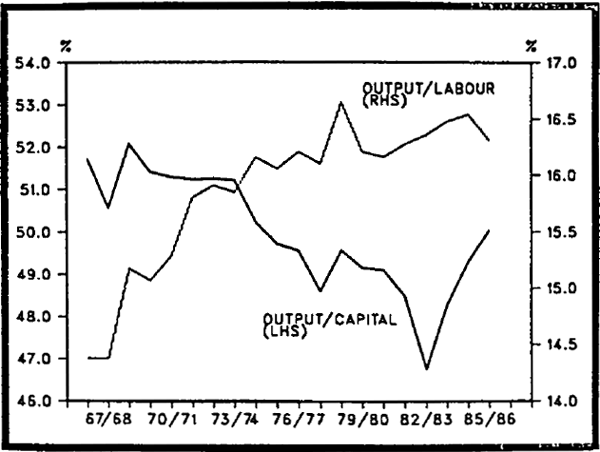
2.3 Factor shares
Another characteristic of the economic system that tends to follow closely from the behaviour of investment and capital is the relative share of production paid to factors. Figure 2.9 shows the post-tax profit share; i.e., the share of production being returned to those who own capital.
GROSS OPERATING SURPLUS LESS TAX
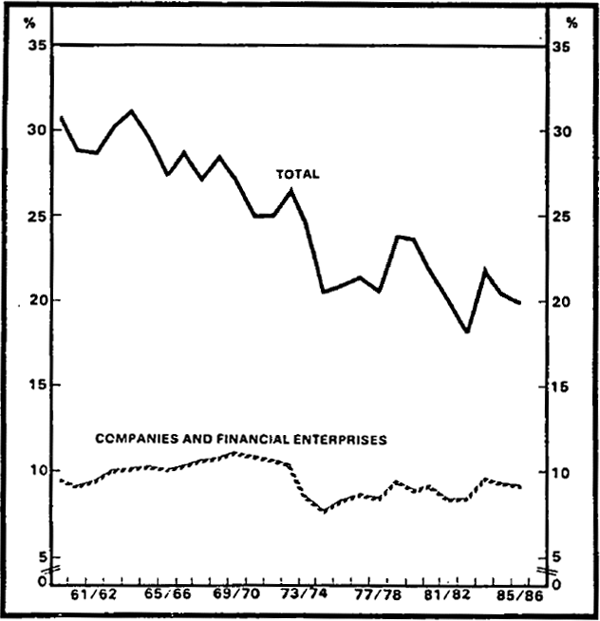
Several features are worthy of note:
- there has been a trend decline in the level of profitability since the early 1960s, much of which has been concentrated in the unincorporated sector;
- a large part of the trend decline in the gross operating surplus of unincorporated enterprises reflects trends in agriculture, forestry and fishing. The profits of unincorporated enterprises in this sector have declined from over 9 per cent of GDP in the early 1960s to average less than 4 per cent of GDP over the past few years; and
- despite a recovery in the past few years, profits of private companies and financial enterprises as a proportion of GDP are still well below the peak reached in the late 1960s and have shown greater volatility since the early 1970s than was evident in previous years.
Figure 2.10 shows the profit shares of the major industry groups. Profitability in mining has followed the pattern of investment fairly closely, with a strong rise in the mid 1970s and again in the recovery since mid 1983. Finance has shown little additional return for the apparent surge of investment in the mid 1970s and again in the early 1980s (part of this surge was, of course, a reflection of leasing activity). Manufacturing has, apart from a once-off downward shift in 1972/73, shown little trend decline in the level of profitability.
GROSS OPERATING SURPLUS BY INDUSTRY
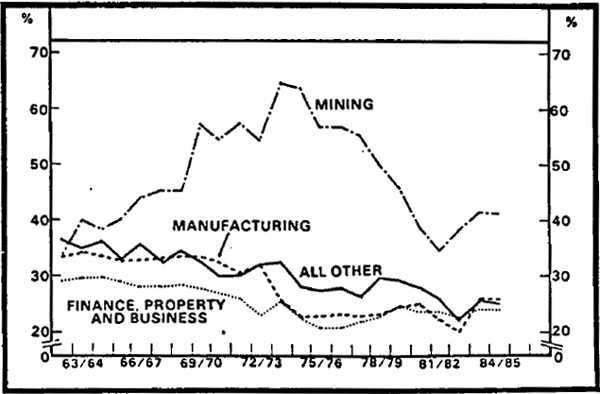
2.4 Summary
Investment in Australia accelerated sharply in the early post-war recovery period. Since then, it has remained at a high level of around 25 per cent of GDP. While a longer-term perspective suggests that Australia's investment performance has been creditable, there is evidence of a slowdown since the mid 1960s, relative to both the post-war average and to experience in other OECD countries. One effect of this slowdown has been a net decline in the capital stock per unit of effective labour over the past decade.
On an industry basis, the pattern of investment has been broadly in line with the structural changes occurring in the economy in this period. There has been a decline in the relative importance of agriculture, a steady increase of investment in tertiary industry and, concentrated into two main periods, a substantial increase of investment in mining and extractive industries.
These trends raise two questions in particular:
- first, to what extent has the performance of investment contributed to the overall macroeconomic performance of the Australian economy?; and
- second, is the performance of investment consistent with general principles of investment theory?;
These questions are taken up in turn in the remaining sections of the paper.
Footnotes
Data in Figures 2.3 and 2.4 are adjusted for major sales of fixed assets between public and private sectors which are leased back to the sector of sale. These transactions involve a change in the legal ownership of assets but do not alter the level of investment effectively undertaken by either sector. [1]
Due to the method of construction, this category also includes purchases of second-hand assets by all industries. [2]
Hall (1984) allocates a fixed proportion of investment in finance, property and business to other industries in proportion to their non-leasehold investment. However, he was not able to incorporate data on leasing by industry (which have only recently become available) and did not allow for the finance, property and business sector's leasing to itself. Consistent with Hall, we have only adjusted for leasing since 1973/74. For details of the methodology used in Figure 2.6(b) see Appendix C. [3]
For a description of labour efficiency units see Section 3.1. The method used to calculate the capital soock is described in Appendix B. [4]